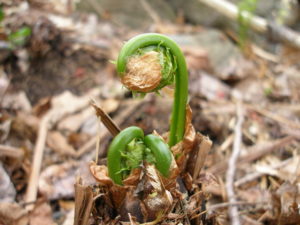There is a rich tradition of foraging for fiddleheads in northern New England. These wild-growing ferns can be a tasty treat, as long as you take care when harvesting and cooking them.
 |
| Ostrich fern fiddlehead by David Fuller, UMaine Cooperative extension |
Find only ostrich ferns
The fiddleheads we know as a regional delicacy are the coiled fronds of the ostrich fern. They take their name from their similarity to the scrolls at the top of a violin. These ferns grow in the early spring, generally in a four- to six-week window between late April and early June.
Most types of ferns have fiddleheads, though, so it’s important to be sure you can expertly identify the ostrich fern before you go foraging. Other types of fern may not be nearly as tasty—and can be harmful.
The University of Maine Cooperative Extension has a helpful guide to identifying ostrich ferns. If you are unsure, it’s better to play it safe.
Thorough cooking is key
Eating raw or undercooked fiddleheads has been associated with a number of outbreaks of foodborne illness over the years. While the exact cause of the food poisoning is not known, symptoms are similar to other kinds of foodborne illness, including vomiting and diarrhea. These symptoms may show up in as little as half an hour, but can take as long as 12 hours to appear.
Take these steps to lower your chances of getting foodborne illness from fiddleheads:
- Wash the fiddleheads thoroughly, until the brown, papery covering has rubbed off and the water runs clean.
- Cook the fiddleheads thoroughly before using them in any recipe. You can steam them in the microwave or on the stove for 10-12 minutes, or boil them for about 15 minutes.
If you have questions about fiddleheads, poisonous plants or foodborne illness, remember the poison center is here 24/7 to help. Just call 1-800-222-1222 or chat online.




